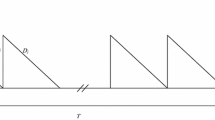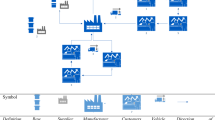Abstract
This paper deals with a combined study of production, reliability and inventory consisting of a single manufacturer and a single retailer with two types of model structures: crisp and stochastic. In the crisp model, manufacturer produces a single type of items with system reliability dependent production cost by offering credit period and warranty period to the retailer and the retailer’s demand has been considered as dependent on system reliability, credit period and selling price. Here, raw-materials’ shortages are allowed within the available stock of produced items. In the stochastic model, volume, cost and weight of the produced items have been considered as random parameters, because in reality, these parameters are not fixed. Again, there may be constraint violation in real life situations, so the constraints are treated as chance constraint here. To deal with this stochastic model we have used chance constraint programming technique. The novelty of this current model is the combination of production, reliability and inventory considering raw-materials’ shortages along with crisp and stochastic sense to find the number of active and cold standby components, number of replenishment and raw-materials’ shortage period which maximize the profit and system reliability. We have done numerical simulations based on different cases of crisp and stochastic models and solved the problems using elitist non-dominated sorting genetic algorithm (NSGA-II) and compared the results. Also, a comparison between active and mixed strategies is presented here. Sensitivity analyses provide managerial insights with the impact of several important parameters on profit, demand and system reliability.























Similar content being viewed by others
Availability of data and material
Not applicable.
References
Bulfin, R.L., Liu, C.Y.: Optimal allocation of redundant components for large systems. IEEE Trans. Reliab. 34(3), 241–247 (1985)
Kim, J.H., Yum, B.J.: A heuristic method for solving redundancy optimization problems in complex systems. IEEE Trans. Reliab. 42(4), 572–578 (1993)
Bhunia, A.K., Sahoo, L., Roy, D.: Reliability stochastic optimization for a series system with interval component reliability via genetic algorithm. Appl. Math. Comput. 216(3), 929–939 (2010)
Liu, Y., Qin, G.: A modified particle swarm optimization algorithm for reliability redundancy optimization problem. J. Comput. 9(9), 2124–2131 (2014)
Xiong, G., Zhang, C., Zhou, F.: A robust reliability redundancy allocation problem under abnormal external failures guided by a new importance measure. Proc. Inst. Mech. Eng. Part O J. Risk Reliab. 231(2), 180–199 (2017)
Pal, S., Mahapatra, G.S., Samanta, G.P.: A production inventory model for deteriorating item with ramp type demand allowing inflation and shortages under fuzziness. Econ. Model. 46, 334–345 (2015)
Manna, A.K., Dey, J.K., Mondal, S.K.: Imperfect production inventory model with production rate dependent defective rate and advertisement dependent demand. Comput. Ind. Eng. 104, 9–22 (2017)
Lu, H., Shi, J.J.: Stockout risk of production-inventory systems with compound Poisson demands. Omega 83, 181–198 (2019)
Panja, S., Mondal, S.K.: Analyzing a four-layer green supply chain imperfect production inventory model for green products under type-2 fuzzy credit period. Comput. Ind. Eng. 129, 435–453 (2019)
Chen, C.K., Lo, C.C., Weng, T.C.: Optimal production run length and warranty period for an imperfect production system under selling price dependent on warranty period. Eur. J. Oper. Res. 259(2), 401–412 (2017)
Banu, A., Mondal, S.K.: An integrated inventory model with warranty dependent credit period under two policies of a manufacturer. Opsearch 55(3–4), 677–702 (2018)
Chien, Y.H.: The effect of a pro-rata rebate warranty on the age replacement policy with salvage value consideration. IEEE Trans. Reliab. 59(2), 383–392 (2010)
Shafiee, M., Chukova, S.: Maintenance models in warranty: a literature review. Eur. J. Oper. Res. 229(3), 561–572 (2013)
Wang, X., He, K., He, Z., Li, L., Xie, M.: Cost analysis of a piece-wise renewing free replacement warranty policy. Comput. Ind. Eng. 135, 1047–1062 (2019)
Bellman, R., Dreyfus, S.: Dynamic programming and the reliability of multicomponent devices. Oper. Res. 6(2), 200–206 (1958)
Misra, K.B., Ljubojevic, M.D.: Optimal reliability design of a system: a new look. IEEE Trans. Reliab. 22(5), 255–258 (1973)
Tillman, F.A., Hwang, C.L., Kuo, W.: Determining component reliability and redundancy for optimum system reliability. IEEE Trans. Reliab. 26(3), 162–165 (1977)
Tavakkoli-Moghaddam, R., Safari, J., Sassani, F.: Reliability optimization of series-parallel systems with a choice of redundancy strategies using a genetic algorithm. Reliab. Eng. Syst. Saf. 93(4), 550–556 (2008)
Rashti Ebrahim Nezhad Moghadam, M., Vishkaei, B.M., Esmaeilpour, R.: A Memtic genetic algorithm for a redundancy allocation problem. Int. J. Appl. Oper. Res. Open Access J. 2(2), 49–57 (2012)
Andiappan, V., Benjamin, M.F.D., Tan, R.R., Ng, D.K.: Design, optimisation and reliability allocation for energy systems based on equipment function and operating capacity. Heliyon 5(10), e02594 (2019)
Maji, A., Bhunia, A.K., Mondal, S.K.: Reliability optimization of parallel-series system with interval valued and fuzzy environment via GA. Int. J. Oper. Res. https://doi.org/10.1504/IJOR.2020.10024987
Mahato, S.K., Sahoo, L., Bhunia, A.K.: Reliability-redundancy optimization problem with interval valued reliabilities of components via genetic algorithm. J. Inf. Comput. Sci. 7(4), 284–295 (2012)
Garg, H.A.R.I.S.H., Sharma, S.P.: Reliability-redundancy allocation problem of pharmaceutical plant. J. Eng. Sci. Technol. 8(2), 190–198 (2013)
Mukherjee, A., Dhar, A.S.: Real-time fault-tolerance with hot-standby topology for conditional sum adder. Microelectron. Reliab. 55(3–4), 704–712 (2015)
Wells, C.E.: Reliability analysis of a single warm-standby system subject to repairable and nonrepairable failures. Eur. J. Oper. Res. 235(1), 180–186 (2014)
Huang, W., Loman, J., Song, T.: A reliability model of a warm standby configuration with two identical sets of units. Reliab. Eng. Syst. Saf. 133, 237–245 (2015)
Grabski, F.: 6 - SM models of renewable cold standby system. In: Grabski F., (ed.). Semi-Markov Processes: Applications in System Reliability and Maintenance. 99–118 (2015)
Franko, C., Ozkut, M., Kan, C.: Reliability of coherent systems with a single cold standby component. J. Comput. Appl. Math. 281, 230–238 (2015)
Coit, D.W.: Cold-standby redundancy optimization for nonrepairable systems. IIE Trans. 33(6), 471–478 (2001)
Ardakan, M.A., Hamadani, A.Z.: Reliability-redundancy allocation problem with cold-standby redundancy strategy. Simul. Model. Pract. Theory 42, 107–118 (2014)
Mellal, M.A., Zio, E.: System reliability-redundancy optimization with cold-standby strategy by an enhanced nest cuckoo optimization algorithm. Reliab. Eng. Syst. Saf. 201, 106973 (2020)
Ardakan, M.A., Hamadani, A.Z.: Reliability optimization of series-parallel systems with mixed redundancy strategy in subsystems. Reliab. Eng. Syst. Saf. 130, 132–139 (2014)
Abouei Ardakan, M., Sima, M., Zeinal Hamadani, A., Coit, D.W.: A novel strategy for redundant components in reliability-redundancy allocation problems. IIE Trans. 48(11), 1043–1057 (2016)
Harris, F.W.: How many parts to make at once. Factory. Mag. Manag. 10(2), 135–136 (1913)
Das, B.C., Das, B., Mondal, S.K.: Optimal transportation and business cycles in an integrated production-inventory model with a discrete credit period. Transp. Res. Part E Logist. Transp. Rev. 68, 1–13 (2014)
Das, B.C., Das, B., Mondal, S.K.: An integrated production inventory model under interactive fuzzy credit period for deteriorating item with several markets. Appl. Soft Comput. 28, 453–465 (2015)
Goyal, S.K.: Economic order quantity under conditions of permissible delay in payments. J. Oper. Res. Soc., 335–338 (1985)
Aggarwal, S.P., Jaggi, C.K.: Ordering policies of deteriorating items under permissible delay in payments. J. Oper. Res. Soc. 46(5), 658–662 (1995)
Chung, K.J.: A theorem on the determination of economic order quantity under conditions of permissible delay in payments. Comput. Oper. Res. 25(1), 49–52 (1998)
Huang, Y.F., Hsu, K.H.: Optimal retailers inventory policy under supplier credits linked to retailer payment time. Math. Comput. Appl. 12(2), 77–86 (2007)
Das, B.C., Das, B., Mondal, S.K.: Integrated supply chain model for a deteriorating item with procurement cost dependent credit period. Comput. Ind. Eng. 64(3), 788–796 (2013)
Das, B.C., Das, B., Mondal, S.K.: An integrated production-inventory model with defective item dependent stochastic credit period. Comput. Ind. Eng. 110, 255–263 (2017)
Manna, A.K., Das, B., Dey, J.K., Mondal, S.K.: Two layers green supply chain imperfect production inventory model under bi-level credit period. Tkhne 15(2), 124–142 (2017)
Das, S.C., Zidan, A.M., Manna, A.K., Shaikh, A.A., Bhunia, A.K.: An application of preservation technology in inventory control system with price dependent demand and partial backlogging. Alex. Eng. J. 59(3), 1359–1369 (2020)
Bhunia, A.K., Shaikh, A.A.: Investigation of two-warehouse inventory problems in interval environment under inflation via particle swarm optimization. Math. Comput. Model. Dyn. Syst. 22(2), 160–179 (2016)
Banu, A., Mondal, S.K.: Analysis of credit linked demand in an inventory model with varying ordering cost. Springerplus 5(1), 1–14 (2016)
Patra, K., Mondal, S.K.: Risk analysis in a production inventory model with fuzzy demand, variable production rate and production time dependent selling price. Opsearch 52(3), 505–529 (2015)
Mallick, R.K., Patra, K., Mondal, S.K.: Mixture inventory model of lost sale and back-order with stochastic lead time demand on permissible delay in payments. Ann. Oper. Res. 292(1), 341–369 (2020)
Dye, C.Y., Yang, C.T.: Sustainable trade credit and replenishment decisions with credit-linked demand under carbon emission constraints. Eur. J. Oper. Res. 244(1), 187–200 (2015)
Alfares, H.K., Ghaithan, A.M.: Inventory and pricing model with price-dependent demand, time-varying holding cost, and quantity discounts. Comput. Ind. Eng. 94, 170–177 (2016)
De, S.K., Sana, S.S.: Fuzzy order quantity inventory model with fuzzy shortage quantity and fuzzy promotional index. Econ. Model. 31, 351–358 (2013)
Wang, W., Lin, M., Fu, Y., Luo, X., Chen, H.: Multi-objective optimization of reliability-redundancy allocation problem for multi-type production systems considering redundancy strategies. Reliab. Eng. Syst. Saf. 193, 106681 (2020)
San-Jos, L.A., Sicilia, J., Gonzlez-De-la-Rosa, M., Febles-Acosta, J.: Analysis of an inventory system with discrete scheduling period, time-dependent demand and backlogged shortages. Comput. Oper. Res. 109, 200–208 (2019)
Sadeghi, J., Sadeghi, S., Niaki, S.T.A.: A hybrid vendor managed inventory and redundancy allocation optimization problem in supply chain management: An NSGA-II with tuned parameters. Comput. Oper. Res. 41, 53–64 (2014)
Alikar, N., Mousavi, S.M., Ghazilla, R.A.R., Tavana, M., Olugu, E.U.: Application of the NSGA-II algorithm to a multi-period inventory-redundancy allocation problem in a series-parallel system. Reliab. Eng. Syst. Saf. 160, 1–10 (2017)
Alikar, N., Mousavi, S.M., Ghazilla, R.A.R., Tavana, M., Olugu, E.U.: A bi-objective multi-period series-parallel inventory-redundancy allocation problem with time value of money and inflation considerations. Comput. Ind. Eng. 104, 51–67 (2017)
Maji, A., Bhunia, A.K., Mondal, S.K.: Exploring a production-inventory model with optimal reliability of the production in a parallel-series system. J. Ind. Prod. Eng. 37(2–3), 71–86 (2020)
Deb, K.: Multi-Objective Optimization Using Evolutionary Algorithms. Wiley, New York, NY (2001)
Fattahi, P., Hajipour, V., Nobari, A.: A bi-objective continuous review inventory control model: Pareto-based meta-heuristic algorithms. Appl. Soft. Comput. 32, 211–223 (2015)
Kim, H., Kim, P.: Reliability-redundancy allocation problem considering optimal redundancy strategy using parallel genetic algorithm. Reliab. Eng. Syst. Saf. 159, 153–160 (2017)
Acknowledgements
The authors wish to thank the handling editor and the anonymous reviewers for their valuable comments and suggestions, which improved the quality of the manuscript.
Funding
This work is supported by the Department of Science and Technology(DST), New Delhi, India, through the letter No.DST/INSPIRE/03/2016/001272.
Author information
Authors and Affiliations
Contributions
AM: Conceptualization, methodology, formal analysis, writing–original draft, visualization, writing–review & editing, funding acquisition. AKB: conceptualization, methodology, writing–review & editing. SKM: conceptualization, methodology, formal analysis, visualization, writing–review & editing, supervision.
Corresponding author
Ethics declarations
Conflict of interests
The authors declare that they have no known competing financial interests or personal relationships that could have appeared to influence the work reported in this paper.
Ethics approval and consent to participate
Not applicable.
Consent for publication
Not applicable.
Additional information
Publisher's Note
Springer Nature remains neutral with regard to jurisdictional claims in published maps and institutional affiliations.
Rights and permissions
About this article
Cite this article
Maji, A., Bhunia, A.K. & Mondal, S.K. A production-reliability-inventory model for a series-parallel system with mixed strategy considering shortage, warranty period, credit period in crisp and stochastic sense. OPSEARCH 59, 862–907 (2022). https://doi.org/10.1007/s12597-022-00578-0
Accepted:
Published:
Issue Date:
DOI: https://doi.org/10.1007/s12597-022-00578-0




